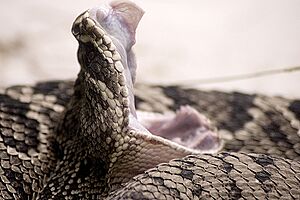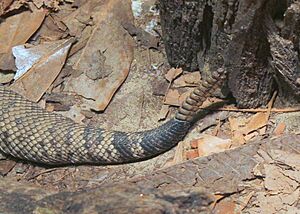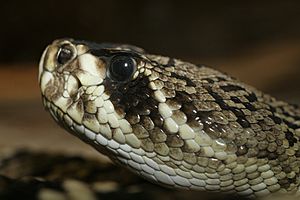Eastern diamondback rattlesnake facts for kids
Quick facts for kids Eastern diamondback rattlesnake |
|
|---|---|
 |
|
| Scientific classification | |
| Kingdom: | |
| Phylum: | |
| Subphylum: | |
| Class: | |
| Order: | |
| Suborder: | |
| Family: | |
| Subfamily: | |
| Genus: | |
| Species: |
C. adamanteus
|
The eastern diamondback rattlesnake (Crotalus adamanteus) is a type of venomous snake. It is a pit viper found in the southeastern United States of America. This snake is the biggest rattlesnake and the heaviest venomous snake in the Americas. There are no different types (subspecies) of this snake known today.
Contents
- What Does the Eastern Diamondback Rattlesnake Look Like?
- What Are Other Names for This Snake?
- Where Do Eastern Diamondback Rattlesnakes Live?
- How Do Eastern Diamondback Rattlesnakes Behave?
- What Do Eastern Diamondback Rattlesnakes Eat?
- How Do Eastern Diamondback Rattlesnakes Reproduce?
- What About Their Venom?
- Images for kids
- See also
What Does the Eastern Diamondback Rattlesnake Look Like?
The eastern diamondback rattlesnake is the heaviest venomous snake in the Americas. It is also the largest rattlesnake. The heaviest one ever found weighed about 15.4 kilograms (34 pounds). It was 2.4 meters (7.8 feet) long. However, this was not the longest one. Some reports say they have seen snakes up to 8 feet long.
Most eastern diamondback rattlesnakes are usually 3 to 5 feet long. They often weigh about 2.3 kg (5.1 pounds). Some bigger ones can weigh 5.12 kg (11.3 pounds) or even 6.7 kg (15 pounds). Their skin is usually brown, yellowish-brown, grayish-brown, or olive green. They have 24 to 35 dark brown or black diamond-shaped spots. These spots have a lighter center. Their belly is yellow or cream colored.
What Are Other Names for This Snake?
People call the eastern diamondback rattlesnake by many names. Some common names include "diamond snake" and "common rattlesnake." It is also known as the "diamond rattler" or the "Florida diamondback snake." Other names are "lozenge-spotted rattlesnake," "southern woodland rattler," and "water rattler."
Where Do Eastern Diamondback Rattlesnakes Live?
These snakes live in different places in the southeastern United States of America. They like dry pine forests and salt marshes. They also live in swamp forests and cypress swamps. You can find them in southeastern North Carolina, Florida, and southern Alabama and Mississippi.
How Do Eastern Diamondback Rattlesnakes Behave?
Like most rattlesnakes, they live on land. They are not very good at climbing. However, some have been seen in bushes and trees. They were probably looking for food there. Even though they are not good climbers, they are very good swimmers. These rattlesnakes often hide in mammal burrows. Hawks, eagles, and other snakes sometimes eat eastern diamondback rattlesnakes.
What Do Eastern Diamondback Rattlesnakes Eat?
The eastern diamondback rattlesnake catches its food by waiting quietly for it. This is called ambushing. They eat small mammals like rabbits and rats. They also eat birds and sometimes lizards. Because adult snakes are large, they can easily attack and eat adult rabbits. There are even reports of them eating turkeys. Young eastern diamondback rattlesnakes mainly eat small rodents. These include mice, rats, and squirrels. Sometimes, they also eat large insects.
How Do Eastern Diamondback Rattlesnakes Reproduce?
Eastern diamondback rattlesnakes, like all rattlesnakes, give birth to live young. This means the babies grow inside the mother. A female snake is pregnant for about five to six months. Then, she gives birth to her young. The baby snakes stay with their mother for a few hours. At most, they stay for a few days. After that, they leave to find food on their own. Because of this, many young snakes do not survive long.
Females usually give birth to 7 to 21 babies at a time. They have their young from July to early October. When they are born, the young snakes are about 30 centimeters (12 inches) long. They look similar to adult snakes. However, they have a small button on their tail. Adult snakes have rattles on their tail instead.
What About Their Venom?

This snake is known as the most dangerous venomous snake in North America. They are not usually aggressive. But they are large and powerful. If someone is bitten, the chance of dying used to be around 30%. Now, studies show it is closer to 10-20% because of better medical care.
The eastern diamondback rattlesnake has the longest fangs of any rattlesnake. Its venom contains a special enzyme called "crotalase." This enzyme can cause blood to clot. The venom also has a small peptide that can affect how muscles work. This could, in theory, lead to heart problems. The venom can cause a lot of damage to tissues. It can also cause pain and a temporary drop in blood pressure.
Images for kids
-
Eastern diamondback rattlesnake at the Saint Louis Zoo
-
In the Universeum science center, Gothenburg, Sweden
See also
 In Spanish: Crótalo adamantino para niños
In Spanish: Crótalo adamantino para niños






